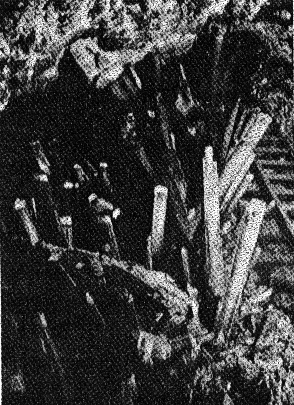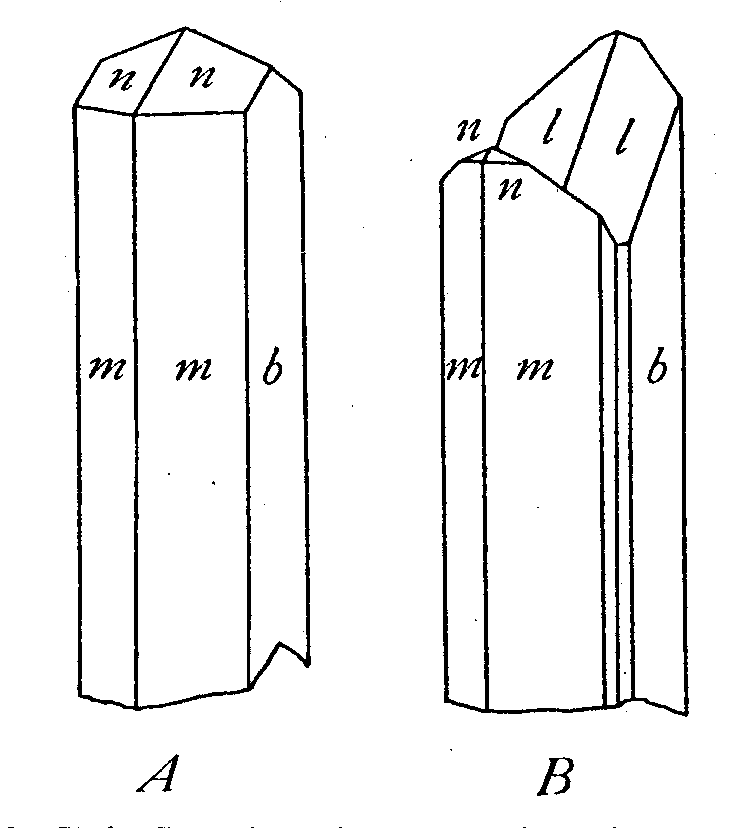| Home | AmMin | GMR | RiMG | Collectors Corner | Directory | Short Courses | |
|
|
|||||||

|
|
Volume 12, pages 252-256, 1927 THE SELENITE CAVES OF NAICA, MEXICO WILLIAM F. FOSHAG, U. S. National Museum.1 A characteristic feature of many of the ore deposits of Mexico that are found in the Cretaceous limestones of the country is the presence of caves in close association with the ore. One such cave discovered in 1912 during mining operations in the Potosi Mine at Santa Eulalia, but now destroyed, was remarkable for the wonderful beauty of its calcite and gypsum crystal growths. It was the habit to illuminate this cavern with a multitude of candles and for sheer brilliance and delicacy it probably surpassed anything yet discovered. In many of these caves calcite predominates, sometimes as botyroidal masses, sometimes in corallike groups of crystals or again as entire coatings of dogtooth spar. In a few, gypsum is the chief mineral and it is usually present in most of them. Of the gypsum caves the most remarkable are those of Naica, a small mining camp in the state of Chihuahua. To reach them one goes to the station of Concho on the Mexican Central R. R. 130 kilometers south of the city of Chihuahua and from here by a narrow gauge line to Naica, a distance of about 30 kilometers. There are two caves at Naica, the better known one being that in the Maravilla Mine. The cave is on the third level and is guarded by a heavy wooden door to prevent the entrance of vandals. It is the habit of the owners, the Naica Mines of Mexico, a subsidiary of the Penoles Company, to care for this cave and to prevent as far as possible the marring of its beauty by the promiscuous removal of crystals, a policy that should be respected by all visitors. A short passage leading from the door takes one to a chamber lined on walls and ceilings with numerous colorless crystals of gypsum from six inches to over a foot in length. The floor of the cave is littered with blocks of limestone that have sluffed off the roof and are now covered with a coating of botryoidal calcite and scattered over with long, blade-like or short stumpy crystals of gypsum. In the grottoes between these boulders of limestone are usually one or more clear selenite crystals like figures in niches. The crystals from the roof and upper walls are partially redissolved so that they resemble icicles rather than crystals but those found in the lower portions of the cave are clear, colorless and well formed. Many contain channels filled with water and carry movable bubbles.
Figure 1. Huge Gypsum Crystals, Maravilla Mine, Naica, Chihuahua, Mexico. (Photo by Foshag.) From this chamber a stairway leads down into an extension where the gypsum crystals have grown to an enormous size. Many of them are four and five feet long and a few probably reach six feet. (fig. 1.) They grow from the floor of the cave in a manner resembling the maguey plants so common on many of the hills of Mexico. These large crystals are colored a light gray by included mud but are often capped by a clear white termination. They are somewhat rounded on their prism zones but are bright and shiny. The walls are studded with scattered crystals of selenite of a stumpy habit. Further on, the way leads thru a narrow opening, just large enough to permit the passage of a man, completely lined with blade-like crystals and forming a veritable corridor of swords. These crystals reach a length of two to three feet and are opaque white in color. From this passage one descends a few feet into the largest chamber of the cave. The floor ahead rises at an angle of about 30° and is completely banked with myriads of selenite blades one to three feet in length. At the crest of the floor there arises a remarkably fine radiated group of crystals over four feet high, gray in color but tipped with white and glistening brightly in the light of the lamps. Nearby is the only huge crystal of the stumpy type noted, a crystal that must weigh sixty pounds. From this single crystal grows a long blade of selenite almost four feet long. Beyond these the cave rapidly narrows until it becomes a mere crack. A second cave in the neighboring Lepanto Mine adjoins the one in the Maravilla and may actually be a continuation of it. In the one chamber of the cave the front and the right walls are covered with. gypsum crystals for about two thirds of their height. The crystals from this cave are entirely of the long bladed habit but are better formed than those of the Maravilla. They lack however, the clear watery transparency of many of those of the latter mine, being colored dark grayish brown by included mud.
As has already been noted the selenite crystals belong to two types: long
prismatic blades and short, stubby ones. The prismatic crystals have the faces b(010),
m(110) and n(
Figure 2. Twin Crystals of Gypsum, Naica, Chihuahua, Mexico. Many of the caves of the type just described are directly connected with ore bodies. At Los Lamentos, for instance, the caves are considered an almost positive indication of ore below and owe their origin to the oxidation of sulphide ores. Although there is a decided increase in the volume of the minerals upon the oxidation of the sulphides, the sulphuric acid and soluble sulphates generated are removed and accounts for a certain amount of the material lost. These spaces are then often considerably enlarged by the action of surface water to form the larger chambers of the caves. The caves at Naica, however, are as far as is now known, not immediately connected with ore bodies and it is obvious upon an inspection of them that they are greatly enlarged cracks or slightly faulted zones. The enlargement has taken place partly by the action of surface waters but also by sulphate waters, the result of sulphide oxidation. The manner of growth of the numerous crystals is not clear, particularly as the caves are now completely dry; and no reasonable suggestion as to the growth of the huge crystals from the floor has occurred to the writer. The author gratefully acknowledges his indebtedness to Prof. Palache for financial assistance from the Holden Fund of Harvard University and to Mr. A. C. Fox, superintendent of the Naica Mines of Mexico, for permission to visit the caves and collect specimens. NOTE 1 Published with the permission of the Secretary of the Smithsonian Institution.
|

